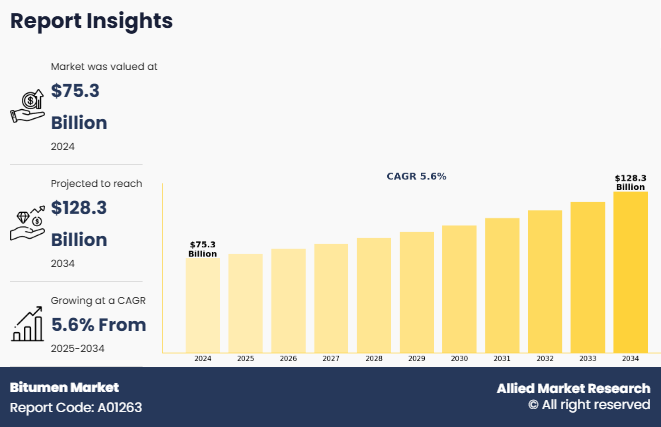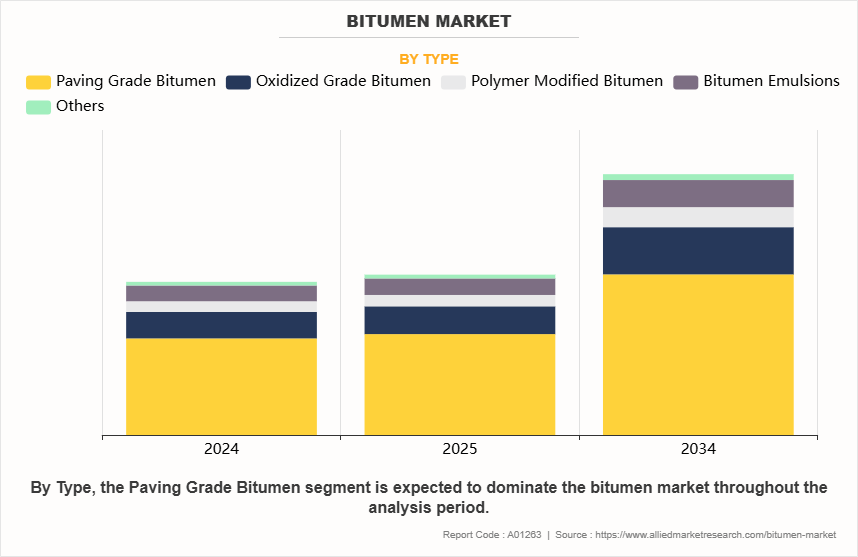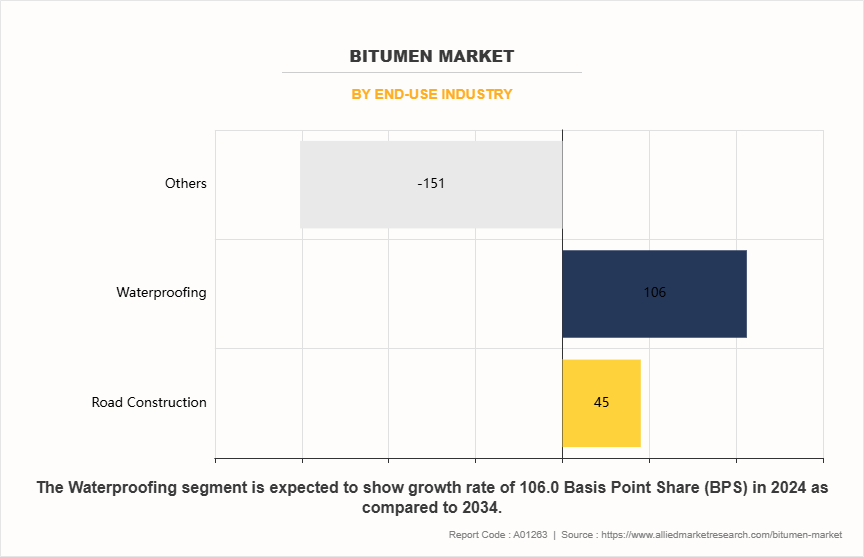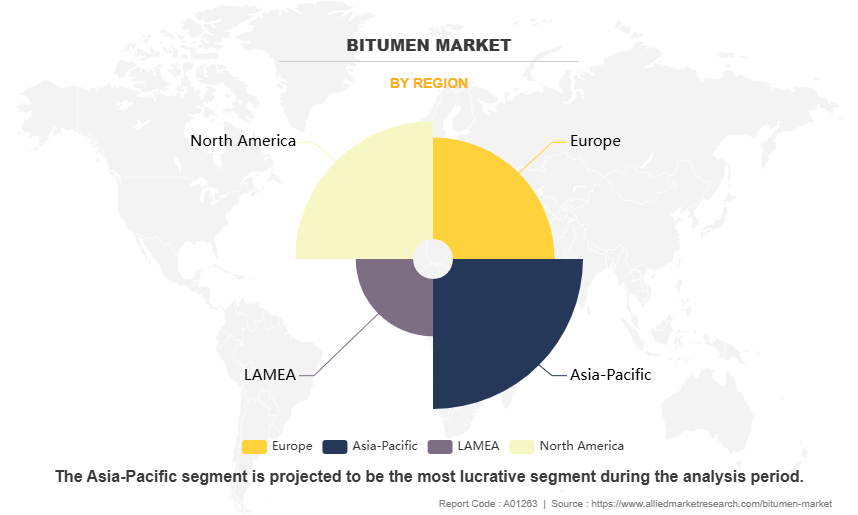Bitumen Market Overview
The global bitumen market was valued at $75.3 billion in 2024, and is projected to reach $128.3 billion by 2034, growing at a CAGR of 5.6% from 2025 to 2034.
Bitumen is a black, sticky, and highly viscous form of petroleum that is primarily used in road construction and waterproofing applications. It is composed of complex hydrocarbons and forms naturally or as a residue from crude oil refining. Bitumen acts as a binder in asphalt, holding aggregates together to form durable road surfaces. It has excellent waterproofing and adhesive properties, making it suitable for roofing and sealing products. The material softens when heated, allowing it to be spread and compacted, then hardens upon cooling, providing structural strength. Its performance is influenced by temperature and traffic load, so different grades are used depending on environmental conditions. Bitumen is recyclable, making it a sustainable choice in modern construction.

Report Key Highlighters
- The report provides competitive dynamics by evaluating business segments, product portfolios, target market revenue, geographical presence and key strategic developments by prominent manufacturers.
- The bitumen market is fragmented in nature among prominent companies such as Total Energies, Royal Dutch Shell Plc, Exxon Mobil Corporation, Indian Oil Corporation Limited, Hindustan Petroleum Corporation Limited, Bharat Petroleum Corporation Limited, Oil and Natural Gas Corporation (ONGC), Sinopec Corp., RAHA Bitumen, Inc., and Tiki Tar Industries India Limited.
- The study contains qualitative information such as the market dynamics (drivers, restraints, challenges, and opportunities), key regulation analysis, pricing analysis, and Porter‐™s Five Force Analysis across North America, Europe, Asia-Pacific, LAMEA regions.
- Latest trends in global bitumen market such as undergoing R&D activities, regulatory guidelines, and government initiatives are analyzed across 16 countries in 4 different regions.
- More than 3,500 bitumen-related product literatures, industry releases, annual reports, and other such documents of key industry participants along with authentic industry journals and government websites have been reviewed for generating high-value industry insights for global bitumen market.
Market Dynamics
The global bitumen market is driven by a confluence of factors, primarily rooted in the growth of the construction and infrastructure sectors, especially in emerging economies. Bitumen, known for its binding properties, plays a critical role in road construction and roofing applications, where it is valued for durability, waterproofing, and resistance to environmental stressors. Rapid urbanization and industrialization in countries such as India, China, and Brazil are intensifying demand for better road networks and urban infrastructure, thereby boosting bitumen consumption. Governments worldwide are initiating large-scale infrastructure projects, such as highways, airports, and urban transit systems, which are reliant on bitumen-based materials. Additionally, increased public-private partnerships in infrastructure development, particularly in Asia-Pacific and Africa, further fuel the market. This growth is not only limited to road paving but extends to bitumen-based roofing materials, which are widely used in both residential and commercial sectors due to their cost-effectiveness and performance in various climates.
Another significant driver of the bitumen market is the increasing use of modified bitumen and bitumen emulsions, which cater to evolving environmental and performance standards. Polymer-modified bitumen (PMB) offers enhanced elasticity, resistance to deformation, and longer life span, making it ideal for high-traffic zones and areas with extreme weather conditions. The rising emphasis on sustainable construction practices is also leading to innovations such as bio-based bitumen and the recycling of asphalt pavement, which support circular economy goals. Moreover, environmental regulations, especially in Europe and North America, are pushing manufacturers to develop low-emission, eco-friendly bitumen products. Bitumen emulsions, which use water as a dispersing agent instead of organic solvents, are gaining traction due to their reduced environmental impact and ease of application. These innovations, combined with growing environmental consciousness, are reshaping market dynamics and attracting investment in research and development.
However, the global bitumen market faces several significant restraints that hinder its long-term growth, primarily stemming from environmental and regulatory challenges. Bitumen is a petroleum-based product, and its extraction, processing, and application raise environmental concerns due to the emission of greenhouse gases (GHGs), volatile organic compounds (VOCs), and other pollutants. With increasing global focus on reducing carbon footprints, many governments are implementing stricter environmental regulations that limit the use of traditional bitumen in construction activities. These include mandates to reduce VOC emissions and adopt greener alternatives, which can increase costs for companies dependent on conventional bitumen. Additionally, climate-related agreements such as the Paris Accord are pushing countries to explore low-emission alternatives, potentially curbing the demand for petroleum-based products. These shifts create compliance challenges for manufacturers, especially those in regions with stringent environmental laws, such as the European Union and parts of North America, thereby slowing market expansion.
On the contrary, with global environmental awareness on the rise, there is growing demand for eco-friendly alternatives that maintain bitumen functional benefits while reducing environmental impact. This includes polymer-modified bitumen (PMB), crumb rubber-modified bitumen (CRMB), and bio-based bitumen made from renewable sources such as lignin or algae. These modified products offer improved performance in terms of flexibility, temperature resistance, and lifespan, which are essential for regions with extreme climates or high-traffic roadways. Moreover, the use of recycled asphalt pavement (RAP) and warm mix asphalt technologies allows for reduced energy consumption and lower greenhouse gas emissions. Companies that invest in research and development to enhance these sustainable alternatives are likely to gain a competitive advantage. Government incentives for green construction and sustainability-focused certifications in developed markets also encourage the adoption of these products, opening doors for both technological advancement and market penetration.
Segments Overview
The global bitumen market is segmented into type, end-use industry, and region. The types covered are paving grade bitumen, oxidized bitumen, polymer modified bitumen, bitumen emulsions and others. By end-use industry, the market is classified into road construction, waterproofing, and others. Region wise, it is analyzed across North America, Europe, Asia-Pacific, and LAMEA.

In 2024, the paving grade bitumen segment was the largest revenue generator, and is anticipated to grow at a CAGR of 5.3% during the forecast period. The demand for paving grade bitumen is increasing globally due to the surge in infrastructure development, especially in emerging economies. As countries expand their transportation networks to support economic growth, urbanization, and population mobility, the need for durable and cost-effective road surfaces has become critical. Paving grade bitumen, known for its strong binding properties, flexibility, and resistance to water and weather extremes, is the preferred material for road construction. Large-scale government initiatives such as India‐™s Bharatmala Pariyojana, China‐™s road expansion under the Belt and Road Initiative, and various highway development programs in Africa and Latin America are creating consistent demand for asphalt roads. Moreover, urban expansion is driving the need for better connectivity, including intra-city roads, flyovers, and expressways, all of which rely heavily on paving grade bitumen for long-lasting performance.

By end-use industry, road construction accounted for the largest share, in terms of revenue in the global bitumen industry ans is anticipated to grow at a CAGR of 5.6% during the forecast period. The demand for bitumen in road construction is growing primarily due to the global surge in infrastructure development and the need for durable, cost-effective road surfaces. As urbanization accelerates, especially in emerging economies like India, China, and Brazil, there is an increasing requirement for improved connectivity through highways, expressways, and rural roads. Bitumen, with its strong binding properties, flexibility, and resistance to weathering, is a key material for asphalt pavements, making it indispensable in both new road construction and rehabilitation projects. Government-led initiatives, such as national highway expansion programs and rural road connectivity schemes, are further driving this demand by investing heavily in transportation infrastructure.

The Asia-Pacific bitumen market size is projected to grow at the highest CAGR of 31.9% during the forecast period and accounted for 28.4% of spearmint oil market share in 2024. The demand for bitumen in the Asia-Pacific region is growing primarily due to rapid infrastructure development and urbanization. Countries like China, India, and Indonesia are undergoing significant urban expansion, resulting in the construction of new roads, highways, and bridges to accommodate increasing populations and vehicle numbers. As these countries invest heavily in infrastructure to support economic growth and improve transportation connectivity, bitumen remains a critical material for road construction and maintenance. Additionally, infrastructure projects, such as smart cities and industrial zones, further boost demand for durable and flexible materials like bitumen to withstand heavy traffic and extreme weather conditions.
Competitive Analysis
The global bitumen market profiles leading players that include Total Energies, Royal Dutch Shell Plc, Exxon Mobil Corporation, Indian Oil Corporation Limited, Hindustan Petroleum Corporation Limited, Bharat Petroleum Corporation Limited, Oil and Natural Gas Corporation (ONGC), Sinopec Corp., RAHA Bitumen, Inc., and Tiki Tar Industries India Limited
Key Benefits For Stakeholders
This report provides a quantitative analysis of the market segments, current trends, estimations, and dynamics of the bitumen market analysis from 2024 to 2034 to identify the prevailing bitumen market opportunities.
The market research is offered along with information related to key drivers, restraints, and opportunities.
Porter's five forces analysis highlights the potency of buyers and suppliers to enable stakeholders make profit-oriented business decisions and strengthen their supplier-buyer network.
In-depth analysis of the bitumen market segmentation assists to determine the prevailing market opportunities.
Major countries in each region are mapped according to their revenue contribution to the global market.
Market player positioning facilitates benchmarking and provides a clear understanding of the present position of the market players.
The report includes the analysis of the regional as well as global bitumen market trends, key players, market segments, application areas, and market growth strategies.
Bitumen Market Report Highlights
| Aspects | Details |
| Market Size By 2034 | USD 128.3 billion |
| Growth Rate | CAGR of 5.6% |
| Forecast period | 2024 - 2034 |
| Report Pages | 328 |
| By Type |
|
| By End-use Industry |
|
| By Region |
|
| Key Market Players | Royal Dutch Shell plc, Oil & Natural Gas Corporation (ONGC), Total Energies, Indian Oil Corporation Limited, Exxon Mobil Corporation, Sinopec Corp., Bharat Petroleum Corporation Limited, RAHA Bitumen, Inc., Tiki Tar Industries India Ltd, Hindustan Petroleum Corporation Ltd |
Analyst Review
According to the CXOs of leading companies, the global bitumen market is poised for steady growth, driven by robust infrastructure development and a shift towards sustainable construction materials. Emerging economies, particularly in Asia-Pacific, are investing heavily in road construction and urban development projects, fueling demand for bitumen products. The adoption of polymer-modified bitumen (PMB) is on the rise due to its superior performance characteristics, including enhanced durability and resistance to extreme weather conditions. Additionally, the development of bio-based bitumen offers an environmentally friendly alternative, aligning with global sustainability goals. However, the market faces challenges such as fluctuating crude oil prices and stringent environmental regulations, which can impact production costs and operational efficiency. To mitigate these risks, companies are focusing on innovation and diversification of their product portfolios. Investments in research and development are crucial to create advanced bitumen products that meet evolving industry standards and environmental requirements. Strategic partnerships and collaborations can also play a vital role in expanding market reach and enhancing technological capabilities. By embracing these strategies, industry leaders can navigate the complexities of the market and capitalize on emerging opportunities.
Growth of the construction and infrastructure sector, increasing use of modified bitumen and bitumen emulsions, and geopolitical developments are the upcoming trends of Bitumen Market in the globe.
Road construction is the leading application of the bitumen market.
Asia-Pacific is the largest regional market for Bitumen.
The global bitumen market was valued at $75.3 billion in 2024, and is projected to reach $128.2 billion by 2034, registering a CAGR of 5.6% from 2025 to 2034.
Total Energies, Royal Dutch Shell Plc, Exxon Mobil Corporation, Indian Oil Corporation Limited, Hindustan Petroleum Corporation Limited, Bharat Petroleum Corporation Limited, Oil and Natural Gas Corporation (ONGC), Sinopec Corp., RAHA Bitumen, Inc., and Tiki Tar Industries India Limited are the top companies to hold the market share in the bitumen market.
Loading Table Of Content...
Loading Research Methodology...



